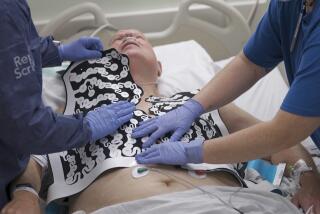Cells Used in Bid to Repair Heart
- Share via
UCLA researchers said Tuesday that they had implanted arm muscle cells into the heart of a 62-year-old heart attack victim in hopes of restoring damaged tissue and avoiding a transplant.
The technique has proved successful in animals and in safety trials in three human patients, but the UCLA effort represents the first time it has been tried in the United States in an effort to rejuvenate a human heart.
Cardiologists will not know for several months whether the experiment has succeeded.
If the approach works, it could eventually be used on most of the 40,000 Americans each year who suffer from severe heart failure. Most such patients are now on waiting lists for heart transplants, but only about 3,000 donor hearts become available every year.
Several groups are working to develop artificial hearts to assist such patients, but cell transplants may represent a more viable option.
“The implications are profound,” said Dr. Mark Sussman of the Children’s Hospital Medical Center in Cincinnati. “The challenge now is to find out just how well these cells can perform new tricks in their new homes.”
“This is the first time we actually have a hope for recovery, not just stabilizing and managing heart patients,” said Dr. Doris Taylor of Duke University, who is planning similar trials. “We might actually be able to regain lost heart function, which would improve the quality and quantity of life.”
The UCLA patient is Edward Cooper, a former Santa Ana city attorney who is retired and living in Laughlin, Nev. Cooper suffered heart attacks in 1977 and 1984 before having a more serious event this Easter that left him with chest pains and difficulty breathing. His heart was beating with only about one-quarter of its normal power.
Cooper’s physicians had previously told him that he was not a good candidate for a bypass graft, but they referred him to Dr. Greg Fonarow at UCLA, who enrolled him in the new program.
In late April, physicians did a biopsy of Cooper’s left arm, removing a small plug of tissue from his biceps. The plug was sent to Diacrin Inc. in Charlestown, Mass., where researchers grew it into hundreds of millions of cells. Arm muscle cells, unlike heart muscle cells, can replicate, allowing researchers to grow large numbers in the laboratory.
On May 11, Dr. Fardad Esmailian of UCLA performed a quadruple bypass on Cooper. During the open-chest surgery, he injected the muscle cells into the back wall of Cooper’s heart, which was largely dead. The injection took only two to three minutes.
Cooper went home in five days and was back at UCLA on Tuesday for his first checkup. “I feel wonderful today,” he told a news conference. He breathes easily, is able to climb stairs, and has no chest pain.
But all those promising symptoms are a result of the bypass, not the muscle implant, said Dr. Robb MacLellan, who is the principal investigator of the UCLA study. It will be several months before the team can determine whether the new cells have strengthened the heart and made it beat more strongly, he said.
Cooper remains on the waiting list for a heart transplant, but the UCLA team’s hope is that his heart will improve to the point that he no longer needs one.
The group plans to perform the procedure on 12 patients in the first phase of the clinical trials. Assuming no adverse effects are observed, the study will be expanded and researchers will begin injecting larger numbers of cells in an effort to demonstrate efficacy, said E. Michael Egan, chief operating officer of Diacrin.
“We don’t know how large that study will be,” he said. If researchers can see new muscle in operation after the injections in the first phase, only a relatively small number of patients will need to be studied. But if all they see is “a lack of progression to heart failure, we will need to study more,” he said.
Another team of researchers that includes Dr. Howard Eisen of Temple University in Philadelphia and Dr. Francis Pagani of the University of Michigan is also testing the Diacrin-grown cells in safety trials.
So far, these researchers have injected the cells into three patients while they were receiving a left ventricular assist device, a sort of mini-heart pump designed to aid the heart and keep the patient alive until a transplant becomes available.
Because of the pump, it will be virtually impossible to determine whether the injected cells actually form new heart muscle, MacLellan said. But those trials have so far shown no adverse effects from the cells.
French researchers have also injected cells into the heart using a different procedure. Dr. Philippe Menasche of Hospital Bichat in Paris reported in November that he took muscle cells from a 72-year-old man’s thigh, grew them in the lab, and injected them into the heart during a bypass operation five months earlier.
He said that the man’s heart pumped somewhat more effectively--although still much less so than a healthy heart--but that it was very difficult to separate the effects of the transplant from those of the bypass.
(BEGIN TEXT OF INFOBOX / INFOGRAPHIC)
Muscle on the Move
UCLA researchers have injected skeletal muscle cells into a heart attack victim’s heart in an effort to replace dead tissue. Here’s how it works:
*
1. A biopsy of muscle tissue is taken from the bicep.
2. The cells are grown in the lab for two weeks to multiply their numbers.
3. During a bypass operation, the cells are injected into the regions of the heart where muscle tissue has died during a heart attack.






